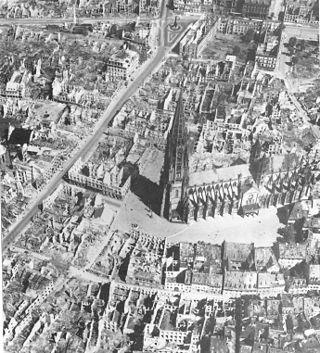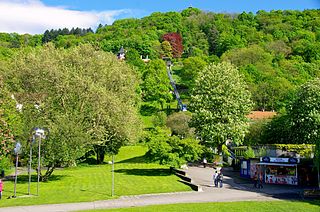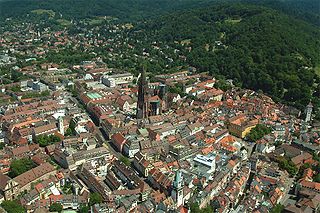

The Augustiner Museum is a museum in Freiburg im Breisgau, Germany located in the former Augustinian Monastery building. It is undergoing an extensive renovation and expansion, the first phase of which ended in 2010. [1] [2] [3]


The Augustiner Museum is a museum in Freiburg im Breisgau, Germany located in the former Augustinian Monastery building. It is undergoing an extensive renovation and expansion, the first phase of which ended in 2010. [1] [2] [3]
The museum is located in a former Augustinian monastery which was rebuilt between 1914 and 1923. The First World War not only interrupted the rebuilding but also severely restricted it compared to the original plans, [3] due to lack of funds. The current total renovation, which is planned to include the addition of new exhibitions rooms, [4] began in 2004. The museum's collection, which was begun by the city of Freiburg in the 1880s, [5] can be only partially exhibited due to the building work.
The visual art and sculpture collection includes works by Lucas Cranach the Elder, Anselm Feuerbach, Hans Baldung Grien, Matthias Grünewald, the Master of the Housebook, Hans Thoma, and Franz Xaver Winterhalter. [3] [4] There is also a sculpture hall with four-metre-high stone prophets from Freiburg Cathedral, [6] a church organ from Welte & Sons with an exterior from the 1730s, and a library of art and cultural history. The Museum of Municipal History (Museum für Stadtgeschichte) is a department of the Augustiner Museum.
The collections that are not on display, or only partially, include a large collection of prints and drawings, [7] decorative art, [8] domestic artefacts from the Black Forest region, collections of coins and timepieces, and a 14th-century carpet.
In 2010 the museum did not make it to the final stage of the Awards for Innovative Developments in Tourism by the British Guild of Travel Writers, but came in sixth. [9]
Since 2004 a general reconstruction of the building site has been taking place. Christoph Mäckler, an architect from Frankfurt, was instructed with the planning. The duration of the reconstruction was originally planned to be 5 to 8 years. Until 2010, during first construction phase, the church building was reconstructed. First, archeological excavations as well as measures to stabilize the church building took place. The roof truss, which was heavily infested with wood preservatives, fungi and other pests, was disinfested, decontaminated and taken off in 2007. The damaged parts were restored. In the summer of 2009 the roof truss was straightened up again and put onto the rest of the building. During this time, the church building was a large construction site. By installing an elevator, the building is now barrier free. This also facilitates the transport of the exhibits. Circular galleries were installed. Additional exhibition space was created in the basement floor to provide for special shows for all of Freiburg's museums. In the attic there is now room for a painting gallery. A café was opened in the former treasury as well as the cloister, which both are on the main floor.
In June 2010, the exhibition hall was opened. In cooperation with the Museum of Modern Arts in Freiburg, the opening was celebrated with a double exhibition of the works by Katharina Grosse and her mother Barbara.
Many of the exhibits can't be shown for spatial and preserving reasons even after the end of the first stage of redevelopment in March 2010. This is why e.g. the section of everyday culture and folklore can't be exhibited yet and the craftwork section is still very fragmentary. This state of repair will remain until the third stage of redevelopment is completed.
The second stage of construction was due to begin in 2010 with the redevelopment and construction of the functional sectors at Salzstraße, where among other sections the collection of graphic arts which consists of more than 70.000 prints and drawings and an appropriate space for deliveries are now located. The gatehouse, which was constructed incorporating historical elements in 1920, was replaced by a new building. According to the Freiburg city council this phase of construction was initially supposed to cost 8.5 million Euros. However this project, which was supposed to be planned in early 2011, was put under scrutiny, since there were cuts in the culture budget of the city. After the second phase of construction had been approved in mid February the gatehouse was taken down in 2012 and archaeological examinations of the site began. Construction started in the summer of 2013. The new building in Salzstraße was finished by the end of 2015 and cost 15,3 million euros.
During the third phase of construction the cloister building is currently (2019) being renovated as well as 3 old cellars.
The Augustiner Museum displays a municipal collection of art which was founded in the 1880s by Lord Mayor Otto Winterer. In 1909, the architect Rudolf Schmidt drafted a conversion of this former cloister into a museum. Until then, the cloister had been used by the Theater Freiburg Theater Freiburg. In 1915, the conversion had to be ceased due to the First World War First World War. Work on the building resumed in 1919 under the direction of architectural historian Karl Gruber. The museum opened its doors in November 1923. Originally, the conversion should have resulted in a central museum site in Freiburg, but due to restricted municipal funds after the war, the conversion had to be carried out in a severely limited and provisional way. The building remained in this provisional state up until 2010. Due to contamination caused by wood preservation agents, some of the museum's wings had been closed for a number of years since they were mostly unusable.
The administrative directors have been:
In 2010, the Association of British Guild of Travel Writers British Guild of Travel Writers awarded the lately refurbished Augustiner Museum as one of the best new tourist attractions worldwide. In their category "best foreign project", the Augustiner Museum was presented as one of only six attractions and was allowed for reviewing.
The western facade of the church building got a new entrance and opens out to the Augustinerplatz with a foyer.
A sculpture hall whose central space remains reserved for original figures and sculptures from the Freiburg Minster is located in the church building reconstructed by Christoph Mäckler. Panel paintings and wood sculptures surround the hall in cabinets on the ground floor as well as the gallery upstairs. Here, works by Matthias Grünewald, Lucas Cranach the Elder, Martin Schaffner and Hans Baldung can be found, along with "Christ on a Donkey" (1350/60), and a number of paintings from the Speyer Altarpiece by the Master of the Housebook (circa 1480). Medieval stained glass from the Freiburg Minster is presented on two levels. The Kaiser windows can also be seen in the dark from the porch entrance outside.
Sculptures, altars, paintings, and statuettes of the Baroque era can be found in the chancel of the former abbey. Large figures overlook the room from within niches of eight-metre high typecases. A narrow, fourteen-metre long display case runs like a ribbon along the side wall. It is home to many statuettes and paintings. The organ case from the abbey church of Gengenbach, which was built in the 1720s, is the showpiece of the museum. The organ itself was attached by the local company M. Welte & Söhne in the year 1935. In the attic one can find paintings from the 19th century by Franz Xaver Winterhalter, Hans Thoma, Anselm Feuerbach and many more. The paintings show the countryside, portraits, genre scenes, allegorical and religious themes. The space which is used to show those pieces of art is around 1.400 square kilometres big, air-conditioned and barrier-free. The basement of the former Augustinian's church?( Augustinerkirche) contains a modern exhibition hall which is almost 450 square kilometres in area. This hall makes it possible for the city of Freiburg to host special exhibitions according to the international conservational standards. The exhibits of the treasure chamber are again available to the public since the 22 January 2011. The chamber contains gold- and silversmithery manufactured from the 9th to 18th century. The items are part of the treasure of the Freiburger Münster. Additionally, there are works from the collections of the archiepiscopal diocesan museum and the Adelhausen foundation.
The pipe organ, consisting of the historical casing (built 1732/33) from the former church of Gengenbach Abbey and a church organ from M. Welte & Sons (built in 1935) is listed under monumental protection as a total work of art and had to be dismantled in the course of the static reconstruction. In the course of 2009, the casing as well as the organ were completely refurbished. After the removal of the brown paintwork from the 19. century, the casing was modeled back to its original state as well as possible. After a Europe-wide, open competitive bidding, the company Waldkircher Orgelbau Jäger & Brommer was chosen to remove later additions to the organ and restore its original tonal condition from 1944. The organ is open for visitors in the scope of groups up to 18 people.
The library of the Augustinermuseum is a public reference library, situated in the administration building in the Gerberau 16. It emphasizes on contemporary art, art history, folklore and craftwork. The holdings are mostly available via the Südwestdeutscher Bibliotheksverbund.

M. Welte & Sons, Freiburg and New York was a manufacturer of orchestrions, organs and reproducing pianos, established in Vöhrenbach by Michael Welte (1807–1880) in 1832.
Franz-Josef Deiters is a German-Australian literary scholar. From 2006 to 2020, he was associate professor in German Studies at Monash University. In December 2021, he was appointed as Honorary Associate with the Department of Germanic Studies at The University of Sydney. Before moving to Australia he taught at University of Tübingen (Germany), and has held visiting appointments at the University of Sarajevo, Johann Wolfgang Goethe University of Frankfurt/M. (Germany) and at the University of Bergamo (Italy). Deiters is a Fellow of the Australian Academy of the Humanities.

The August Kestner Museum, previously Kestner-Museum, is a museum in Hanover, Germany. Founded in 1889, the museum was renamed in December 2007 to avoid confusion with the Kestnergesellschaft, a local art gallery.
Wolfgang Schäfer is a German choral conductor and academic. He founded the Freiburger Vokalensemble, the BosArt Trio, and the Frankfurter Kammerchor.

The Liebenau monastery was a Dominican monastery. It was located outside the city gates of Worms in today's Worms-Hochheim district.

Operation Tigerfish was the military code name in World War II for the air raid on Freiburg in the evening of 27 November 1944 by the Royal Air Force with about 2,800 dead.

The Freiburg im Breisgau tramway network is a network of tramways that forms part of the public transport system in Freiburg im Breisgau, a city in the federal state of Baden-Württemberg, Germany. Established in 1901, the network has been operated since its foundation by the company now known as Freiburger Verkehrs, and powered by electricity. The tramway network currently has five lines. The expansion of the tram network since 1980 has served as an example of the "renaissance of the trams" in Germany. As of 2023, 73 trams were available for regular use: 2 of these were high-floored, 36 partial and 35 low-floored. Almost the entirety of the network is located within Freiburg's urban area; only a few metres of the balloon loop at Gundelfinger Straße are located outside the boundary of Gundelfingen to the north of Freiburg. In total, the trams serve 20 out of the 28 districts in Freiburg.

The Struve Putsch, also known as the Second Baden Uprising or Second Baden Rebellion, was a regional, South Baden element of the German Revolution of 1848/1849. It began with the proclamation of the German Republic on 21 September 1848 by Gustav Struve in Lörrach and ended with his arrest on 25 September 1848 in Wehr.

The Siegesdenkmal in Freiburg im Breisgau is a monument to the German victory in the Franco-Prussian War in 1871. It was erected at the northern edge of the historic center of Freiburg im Breisgau next to the former Karlskaserne (barracks). After World War II it was moved 100m to the west. Today it is located on Europaplatz.

The Augustinian Monastery of Freiburg is a former Augustinian monastery located in the Salzstraße, in the historic center of Freiburg im Breisgau.

Günterstal Abbey, earlier also Güntersthal Abbey, was a Cistercian nunnery that existed from 1221 to 1806 located in Günterstal, which today is a district in Freiburg im Breisgau, Germany.

The Whale House is a late Gothic bourgeois house in the old town of Freiburg im Breisgau, Baden-Württemberg, Germany and is under conservation. The building is currently used by the Sparkasse Freiburg-Nördlicher Breisgau bank. It is part of a complex which, in the past, was made up of 17 separate buildings. The front wall of the house opens onto the Franziskanerstraße, whilst the rear is on the Gauchstraße, near Kartoffelmarkt square.
The Salzstraße in Freiburg im Breisgau is a significant part of the Freiburg city centre pedestrian area. It runs from Bertoldsbrunnen to Kaiser-Joseph-Straße, then eastward to Oberlinden square, where a fountain of the same name is located. It is probably the location of Freiburg's oldest houses. A stream, the Freiburg Bächle, runs along the street's northern side between the tramway tracks and the pavement.

The Colombischlössle is a manor house in the city centre of Freiburg im Breisgau where the eponymous archaeological museum is situated.

The Stadtgarten of Freiburg is a 2.6 ha park within the Neuburg district. It has an old tree grove and a large rose garden, and lies between the Leopoldring, Jackob Burckhardt, Ludwig and Mozart streets near Freiburg's city centre. It is connected to Karlsplatz via the Karlssteg footbridge, which is made from pre-stressed concrete. Since 2008 the Schlossberg Tram, an inclined elevator, leads up to Schlossberg. It replaced the Schlossberg Cable Car built in 1968.

The Old City of Freiburg is part of the city and business centres of Freiburg im Breisgau and is the core of the original city. It is divided into the two districts 111 Altstadt-Mitte and 112 Altstadt-Ring. The Altstadt-Mitte district was the city's build-up area at the time of its foundation and therefore formed the old city. The district Altstadt-Ring is connected westwards to the railway line and south to the Dreisam.

Neuburg is a quarter of the German city Freiburg im Breisgau. The district is located directly north of the old town with its numerous sights and includes the Schlossberg which is situated east of the city's historic center. Neuburg adjoins the district Oberau on wooded Schlossberg, as well as it adjoins Herdern in the north. On its western side, the district is cut off from Stühlinger by the tracks of the Rheintalbahn running from Mannheim to Basel.

Hans Wydyz or Weiditz the Elder (c.1470–1520) was a sculptor and artist operating in Germany in the early 16th century. His work is usually signed H. W. near the base. He sculpted mainly in wood and also created woodcuts.

The Kunsthalle Messmer is a museum in Riegel am Kaiserstuhl in the rooms of the former Riegeler Brauerei. Art of the 20th and 21st centuries is shown in temporary exhibitions on around 900 m2 of exhibition space. The museum includes an 850 m2 sculpture garden with plastics by contemporary artists Gerald Baschek, Hellmut Bruch, Gerhard Frömel, Friedrich Geiler, Bernhard Licini, Rüdiger Seidt, Michel Jouët and Michael Schwarze.

The village Günterstal is the southernmost district of Freiburg im Breisgau. It is located in the so-called Bohrer-Tal area at the foot of the 1284 metre-high Schauinsland in the Günterstal district of the Black Forest. Due to this, Freiburg prides itself on being Germany's highest city. Günterstal has more than 2,000 inhabitants and is separated from Freiburg by a two-kilometre-wide meadow, the "Wonnhaldewiesen". The village was incorporated into Freiburg in 1890. The southern neighbouring municipality is Horben.